The Road to Two Degrees, Part One: Feasible Emissions Pathways, Burying our Carbon, and Bioenergy
Posted on 16 November 2015 by Andy Skuce
This post looks at the feasibility of the massive and rapid deployment of Carbon Capture and Storage and negative-emissions Bioenergy Carbon Capture and Storage technologies in the majority of IPCC scenarios that avoid dangerous global warming. Some observers question whether the deployment of these technologies at these scales and within the required time frames is achievable. This is Part One of a three-part series on the challenge of keeping global warming under 2 °C.
The various emissions models that have been used to produce the greenhouse gas concentration pathway to 2°Celsius vary considerably, but the majority of them require huge deployment of Carbon Capture and Storage (CCS) as well as net-negative global emissions in the latter part of the twenty-first century. The only negative emissions methods generally considered in these scenarios are bioenergy capture and storage (BECCS) and land-use changes, such as afforestation. For there to be net-negative emissions, positive emissions have to be smaller than the negative emissions.
Kevin Anderson (2015) (open-access text) reports that of the 400 scenarios that have a 50% chance or greater of no more than 2 °C of warming, 344 assume large-scale negative emissions technologies. The remaining 56 scenarios have emissions peaking in 2010, which, as we know, did not happen.
Sabine Fuss et al. (2014) (pdf) demonstrate that of the 116 scenarios that lead to concentrations of 430-480 ppm of CO2 equivalent, 101 of them require net negative emissions. Most scenarios that have net-negative emissions have BECCS providing 10-30% of the world’s primary energy in 2100.
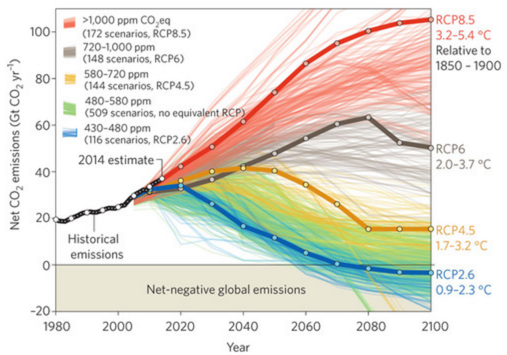
From Fuss et al. (2014), showing the historical emissions (black), the four RCPs (heavy coloured lines) and 1089 scenarios assigned to one of the RCPs (light coloured lines).
The scenario modellers have come to rely on BECCS because some form of large-scale negative emissions technology is economically optimal and BECCS provides, for now, the only plausible method of achieving that end at the scale required. CCS as a mitigation technology has limitations in that it is currently only 85-95% efficient at removing CO2 from a power plant (Scott et al., 2013), it does not work for non-stationary CO2 sources like ships and aeroplanes, nor for many agricultural emissions. To get even to zero net emissions (and get there we must to avoid >2 °C warming), negative emissions technologies are necessary. And to correct for emissions overshoot before 2050, net negative emissions are required in the latter half of the century, requiring an even bigger deployment of BECCS.
BECCS at the large scales envisaged in many scenarios, will place huge demands on land use, with important consequences for food security and biodiversity. The use of bioenergy in Europe, which currently makes up half of the renewable energy used in the EU, is already causing major land-use impacts in the SE United States, as outlined in the excellent series of articles titled Pulp Fiction by John Upton at Climate Central. Just one region of the world relying on biomass for ~6% of its primary energy is already causing land-use problems outside its borders.
Upton points out that the use of biomass in Europe hinges on assumptions that it is carbon-neutral. The climate impact of wood burning depends to a great deal on the type of wood used, as this UK Department of Energy and Climate Change report shows. It depends, for example, on whether the wood comes from harvesting of natural forests that would otherwise remain untouched, or whether the wood comes from waste from logging operations that would have happened anyway, or any number of other scenarios in between. It also matters what time period the impacts are measured over. It’s complicated, in other words, but whatever the scenario, the GHG impact of biomass burning is not zero. In some cases, the impact can be worse than coal.
Putting aside, for now, the important issues of land-use and bioenergy emissions, let’s look at the feasibility of the “S” in CCS and BECCS: storage.
Six thousand feet under
The following graphs are derived from the scenario described in Van Vuuren et al (2011). Some are taken directly from the paper, but I have generated others myself, based in part on information kindly provided by Detleff van Vuuren. I have made a number of assumptions in my calculations, and the graphs and numbers I have generated myself are just back-of-the envelope quality.

Showing global primary energy use (in ExaJoules) for the RCP2.6 scenario. From Van Vuuren et al. (2011), part of their Figure 2.
The total energy consumed doubles from 2010 to 2100. Over that period bio-energy use increases five-fold and, after 2020, the use of CCS and BECCS increases dramatically to make up roughly half of the energy supply. Let’s rearrange that graph to look at fossil fuels only.
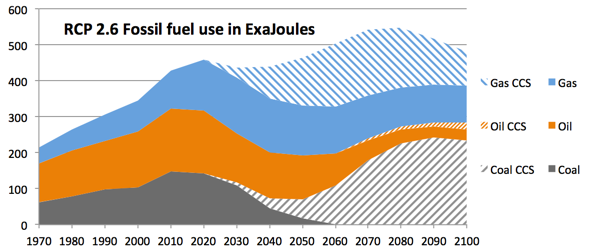
Coal and gas use expands through the century (with an odd-looking saddle for coal in mid-century), but oil use peaks around 2020. All of the coal emissions after 2060 are captured and sequestered, but about half the gas and almost none of the remaining oil emissions are. When any fossil fuel is combusted, it produces somewhere between 2.8 and 3.7 of its original mass as CO2. We can estimate the mass of CO2 that needs to be sequestered and plot it against the mass of the original fuels, as follows (the figure excludes the mass of the biofuels):
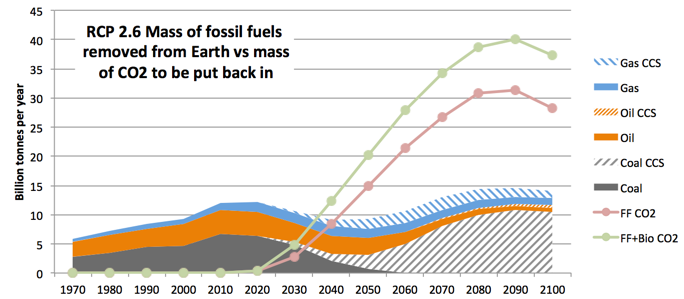
This graph shows the huge mass of CO2 that will need to be stored in disposal sites by the end of the century from fossil and biofuels under this scenario: about four times the total mass of fossil fuels produced in 2000. The fourteen CCS plants currently in operation on average sequester 2 million tonnes of CO2 per year, so we would need 20,000 such plants running by 2090. (Incidentally, only three of these current projects are not dedicated to enhanced oil recovery.) Between 2030 and 2080, this would involve adding roughly one 2-million tonne plant every day. Future CCS plants are likely to be much bigger than the current demonstration projects, but even if they have an average capacity of 10 million tonnes per day, that would involve building one big facility every five days for fifty years.
If we assume a cost of $50/tonne for CCS, this will entail a cost of $2 trillion per year by the end of the century, an amount that exceeds current global military spending.
Looking at the mass gives an impression of how much CO2 needs to be handled at the surface, but does not tell us much about the volumes that need to be sequestered back in the Earth. When CO2 is stored at typical temperature and pressure conditions it will be in the form of a super-critical fluid with a density of roughly 0.6 gm/cc. Natural gas in a reservoir at a depth of 2000m will be compressed approximately 180 times. This factor depends on the specific temperature and pressure of the reservoir as well as the chemical composition of the gas, so this is just a rough figure used for illustrative purposes.
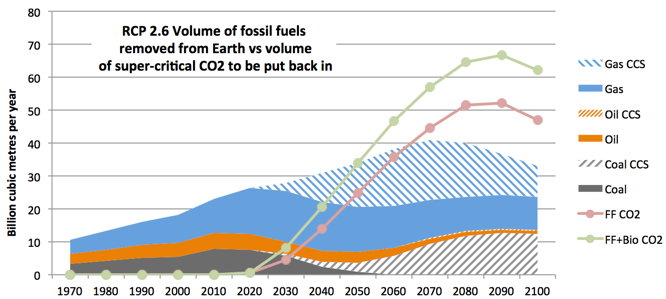
By the end of the century, under this scenario, we would therefore be sequestering 50 billion cubic metres of CO2 from fossil fuels every year with an additional 15 billion cubic metres from biofuels. For comparison, this is about three times the volume of fossil fuels extracted from the Earth in 2010. Expressed another way, that’s equivalent to disposing of the volume of Lake Erie underground every 7 or 8 years. Human sequestration of CO2 will exceed the natural oceanic uptake sometime in the mid-century.
Pumping this volume of fluid into the subsurface is going to have consequences. There are very few underground voids waiting to be filled and existing fluids, mostly brines, will be displaced. They will have to find their way to the surface somehow. Many potential risks associated with CO2 sequestration have already been identified and although some of these can be avoided with careful site selection, monitoring and engineering, at the scales required by most 2°C scenarios, there will inevitably be sites selected for CCS that are less than optimal.
Vaclav Smil has made similar observations about the masses and volumes associated with significant CCS. In this video he outlines the difficulty of adopting large-scale CCS adoption over just a few decades.
Recently, Shell has started a CCS project in Alberta that they have called Quest that plans to extract 1 million tonnes per year of CO2 from the exhaust of a heavy oil upgrader and then pump the CO2 into the basal Cambrian sandstone layer. This is a promising project, although emissions for Alberta's upstream oil and gas industry in 2013 were 73 million tonnes of CO2e, so approximately 70 such plants would be required to render the upstream petroleum industry carbon neutral. The project receives generous government grants and the estimated cost is $72 per tonne. Let's hope it works and that projects like this can be repeated safely and more cheaply.
The great CCS disconnect
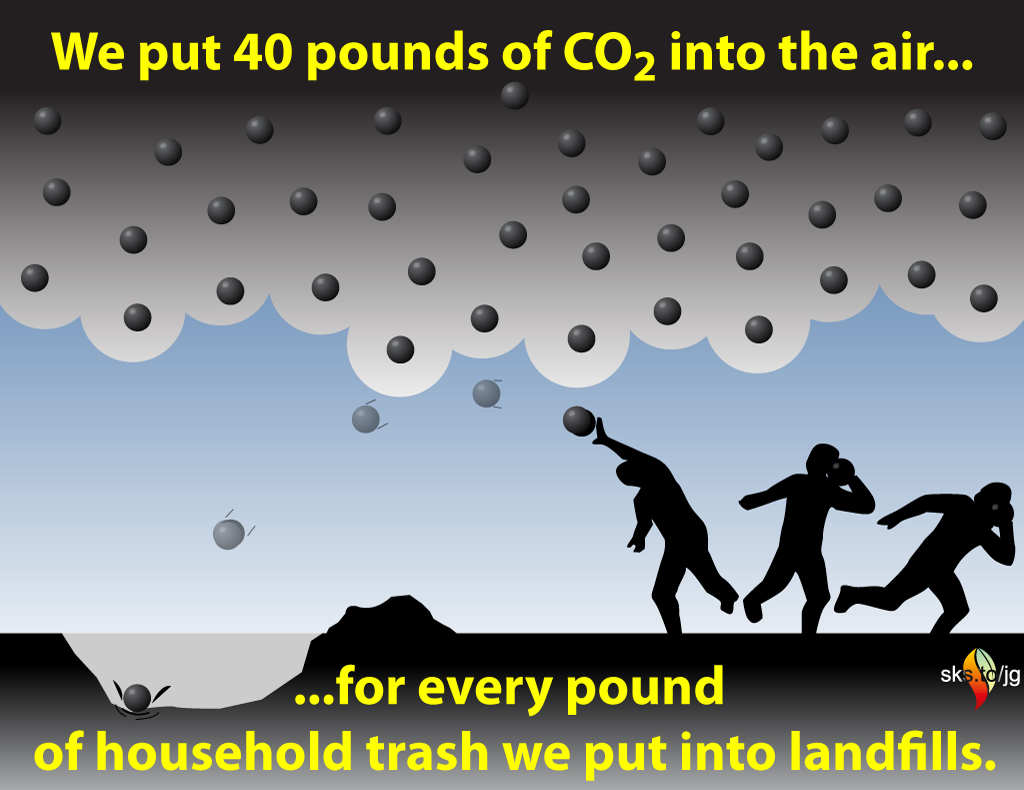
Already, in the more crowded parts of the world, we struggle to find sufficient space to dump our household trash. Yet, the mass of CO2 that we produce is forty times that amount. Even if we have the funds to do it and have general public buy-in to the necessity of CCS, finding safe waste disposal sites and securing community licence is going to be a monumental problem. We are likely to see the same kind of resistance we see now to fracking and nuclear waste disposal, but on a larger scale. A jaded and suspicious public is not likely to be easily reassured by experts that CCS is safe. Expect a new acronym to be coined: NUMBY (Not Under My Back Yard). (For what it's worth, compacted garbage has around the the same density as supercritical CO2, so the forty-to-one mass ratio would still apply very roughly to volumes.)
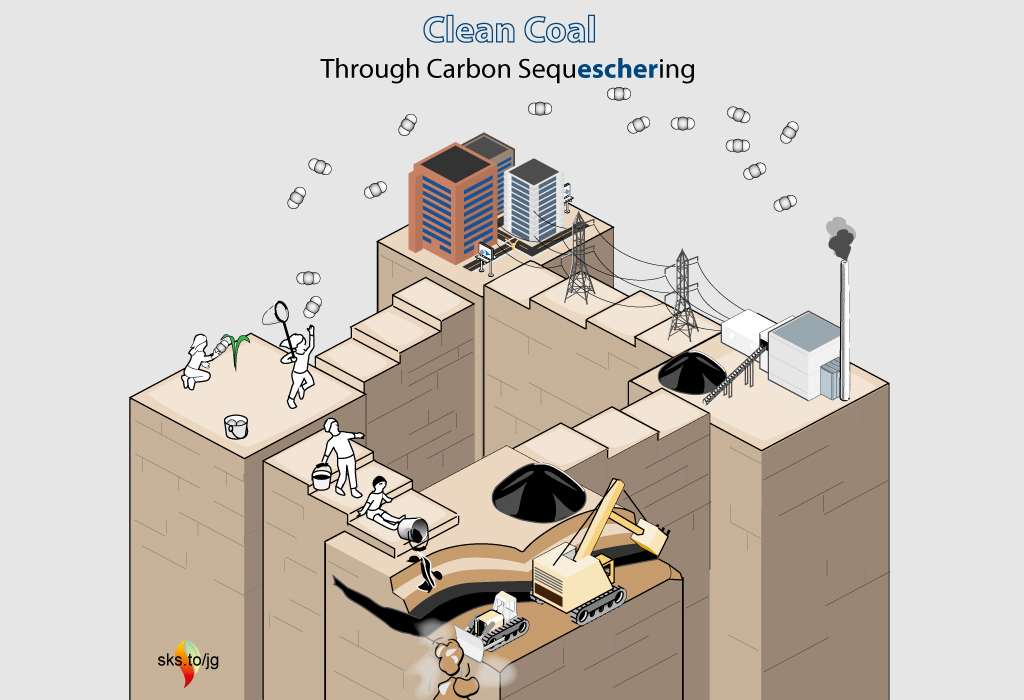
Governments have made some token efforts to support pilot projects in CCS, but many initiatives have fallen through. The fossil-fuel industry stands to gain doubly by an expanded CCS industry, since it gives extra life to their assets and, because they have expertise with handling fluids in the subsurface, they will capture most of the investment required to dispose of CO2. Nevertheless, private industry research efforts are half-hearted at best and are mostly limited to EOR projects. There's an element of absurdity to processes that dispose of CO2 only to produce more fossil fuels.
None of this discussion should be taken to imply that CCS or BECCS technologies will play no role in mitigation, it's just that relying on them to dispose of tens of billions of cubic metres of CO2 in the latter half of the century does not seem to be prudent. CCS at this scale is not the only path to 2 degrees and we will surely have to push energy demand reductions, solar and wind energy and nuclear energy as hard as we can if we are to to ensure avoiding dangerous climate change.
Even if the scenario laid out by van Vuuren et al. did unfold as they imagine, the job of the CCS/BECCS solution for avoiding dangerous climate change would not end in 2100. Unless the energy supply is replaced by a genuinely sustainable source, we will be stuck on a treadmill of digging up carbon and putting it back. The cycle will have to continue until we run out of resources to burn or space to sequester the CO2. In the long term, this is not a solution but a stop-gap.
There is a massive disconnect between what the modellers say we have to do and what we are actually doing. We won't solve the problem if we don't acknowledge how huge the challenge really is.
References
Anderson, K. (2015). Duality in climate science. Nature Geoscience. (open access text)
Fuss, S., Canadell, J. G., Peters, G. P., Tavoni, M., Andrew, R. M., Ciais, P., ... & Yamagata, Y. (2014). Betting on negative emissions. Nature Climate Change, 4(10), 850-853. pdf
Scott, V., Gilfillan, S., Markusson, N., Chalmers, H., & Haszeldine, R. S. (2013). Last chance for carbon capture and storage. Nature Climate Change, 3(2), 105-111.
Van Vuuren, D. P., Stehfest, E., den Elzen, M. G., Kram, T., van Vliet, J., Deetman, S., ... & van Ruijven, B. (2011). RCP2. 6: exploring the possibility to keep global mean temperature increase below 2 C. Climatic Change, 109(1-2), 95-116. pdf
In the second part of this series, I will look at a recent paper by Kevin Anderson, who argues that climate scientists and policy makers have been less than candid about the level of difficulty that we all face in avoiding dangerous climate change.































 Arguments
Arguments































I'm not sure it's valid to consider RCP scenarios without also considering the effect of the increasing world population and our decreasing ability to feed everyone — an ability that is being increasingly compromised by climate change. Optimistic statements to the contrary, it seems from all I've read on the subject that we'll reach a tipping point in the near future. At this point a lot of people will die of starvation and strife.
How is CCS going to prevent such a catastrophe? The graph shows CCS increasing from about 2030 to 2040 onwards. That's exactly the time when the aforementioned tipping point is likely to occur. In other words, it will be too late.
CCS worries me. for every atom of carbon locked away we lose two atoms of oxygen. It depletes the atmosphere in general as well. I can't help but think the cure might be worse than the disease, like the little old lady who swallowed the fly. I would hope instead that using graphene enhanced solar cells batteries and capacitors, renewable energy will deploy rapidly and avoid this drastic soloution.
No need to panic:
Emphasis added.
SOURCE
Yes, and thanks to the wonders of photosynthesis, so long as we have CO2 in the atmosphere, we will also have O2.
Daneil: Thanks for the reasuring numbers but it is still creepy.
scaddenp: That was kind of my point, the co2 we made would eventually come back as oxygen if we stop burning FF. Heres hoping we get on that sooner rather than later.
Tom Curtis provided a nice explainer on the drop in atmospheric oxygen in his Climate Change Cluedo post, part 6 It includes this IPCC diagram, which I find very useful. See Tom's text for a very clear explanation.
"480 CO2e…
Unfortunately, the global CO2 measure doesn’t tell quite the entire story. For atmospheric levels of gasses like methane, nitrous oxide, and a host of less common industrial chemicals have also all been on the rise in Earth’s atmosphere due to human emissions. As a result, according to research by the Advanced Global Atmospheric Gasses Center at MIT, total heat forcing equal to CO2 when all the other gasses were added in was about 478 ppm CO2e during the spring of 2013. Adding in the high-velocity human greenhouse gas contributions since that time gets us to around 480 ppm CO2e value. In the context of past climates and of near and long term climate changes due to human interference, 480 ppm CO2e is nothing short of fearsome."
http://robertscribbler.com/tag/480-ppm-co2e/
Yet the 2.6RCP in Figue 1 (Fuss) gets to max 480CO2e by 2100 with another 50 years of net positive emissions, those negative emissions must be huge to clear it allotu agaim in 20years, yet they look quite small....makes you wonder about the realism here??
And as there is growing evidence that the climate sensitivity more likely to be between 3C-4.5C, is it possible that these predicted temperature range % chances will be too low due to including models with unrealistically low climate sensitivities (<3C)?
Maybe a better way to consider the CO2 levels needed is to consult the past as the primary measure?
Last time the CO2 was 400-450ppm, the world was 4-6C hotter, and sea levels 30-40m higher in the Miocene?
300ppm average is ~current temperature when this record breaking 2015 El NIno fully matures and sea levels 6-9m higher back then, and weare well above this 300ppm and have put the CO2 in incredibly fast (faster than seen in geological records so far).
Can't help feeling as the resulting heat input will presumeably also be faster than has occured previously as well that melt rates could exceed previous records and many expectations?
400-450ppm means eventual 30-40m over the next millenia, but that rate must depend on heat rate input as well, and previously 4-5m a century have occured in Ice sheets melts.
Even 1-2m means moving potentially having to move some major coastal cities and that 1-2m seems highly likely by 2100 even if stopped all emissions today and things went immediately carbon negative.
War apparently causes massive amounts of CO2 emissions and ecosystem devastation.
This is not factored into the CO2 emissions scenarios though (we have plenty of war though), and additional CO2 emissions from war induced ecosystem dessimations aren't either, nor permafrsot melt, nor peat burning in Indonesia, nor forest fires, nor the reductions in CO2 fertilisations as nutrients decline, species are foresd to shift climatic zones and drought and rain become unprecedented.
BECCs impacts on ecosystems probably aren't factored in either and presume biomass growth consistency using industrial know how, and thus widespread environmental impacts (pesticides, fertilizes etc).
300ppm seems safe...ish?, that is eventual sea level rise of 6-9m and temperature between current and 2C as the final outcome.
Is 300ppm CO2e by 2100 impossible?
And what does the reasonably possible 2m by 2100 sea levels rise actually mean for places New York in less than a century's time?
Remember to add in the storm induced sea surge growth as well?
It would be good to see a treatment of the potential for carbon sequestration through sustainable biomass pyrolysis + addition of biochar to soil. It doesn't look like an inexpensive option, and it won't necessarily work everywhere - but the same is true of BECCS.
Meurig: there are several other sequestration methods, biochar among them, that I didn't attempt to cover here. Others would be mineral sequestration (olivine or basalts) and various forms of sequestration in the sea by iron fertilization or pumping CO2 into the ocean depths. All of these methods are even more speculative and untried than geosequestration. Some of them are hard to scale, some don't offer a permanent store and some might just be too expensive to deploy.
That doesn't mean that I would necessarily write these technologies off, just that making them a big part of a mitigation scenario now would be premature. The main point I was trying to make here is that, if you rely on sequestration as the main response to the climate crisis, you are facing a gigantic problem no matter what technology you employ.
Andy Skuse: That sums it up well: to "rely on sequestration as the main response to the climate crisis" would be to face "a gigantic problem". Some sequestration would help but it cannot be used as an excuse not to cut the burning of fossil fuel.
With regard to the latter, I'm busy reading Tim Flannery's "Atmosphere of hope" and find it difficult to reconcile his comments on our "carbon budget" with the graph showing RCP 2.6 fossil-fuel use. He states that we have a budget of 600 Gt of carbon dioxide remaining and are currently emitting just over 30 Gt annually from burning fossil fuel. At current rates we'll use up the budget by 2028. Even if the rate is capped at 30 Gt, that still extends the deadline to 2035 only.
I've seen similar figures elsewhere but I've also seen comments disparaging the whole idea of trying to quantify a carbon budget — the uncertainties are large. If we accept the budget of 600 Gt, then we can carry on as usual for about two decades and then we have to stop burning fossil fuel completely. If the rate of fossil-fuel use declines considerably, then we can continue for longer.
Now, if I look at the above graph, I see the use of oil and gas declining only slightly over the next two or three decades. Coal use declines a lot and is compensated for by the use of gas plus CCS. However, the overall reduction in fossil-fuel use does not seem in any way sufficient to meet Flannery's requirement. Have I misinterpreted things? Has Flannery erred? Is the RCP 2.6 graph only part of the picture?
Digby: In the second and third graphs, I think it's clear that fossil fuel use without CCS peaks in 2020, followed by a decline, with, for example, no coal without CCS after 2060. Although that's a very ambitious mitigation scenario, it still overshoots the carbon budget, requiring net negative emissions after 2060, as shown in the first figure in my original post. That's where the BECCS is needed.
The 600Gt CO2 budget number that Flannery mentions is a lot lower than the figure of 1000Gt that you would find in the IPCC AR5 reports for a 66% chance of staying below 2 degrees. However, the lower number is more appropriate as a go-forward budget for fossil fuel use from now, because you have to subtract the three years or so of emissions since AR5, as well as make allowance for cement and land-use emissions over the rest of the century.
Andy: I was using my mark-one eyeball to estimate the changes in gas and oil use from the thicknesses of the blue and orange bands. Gas use seems hardly to change at all up to 2030 or so. Oil use does decline somewhat. But even with the large decline in coal use, the overall rate of decline in fossil-fuel use for the next two decades still does not seem drastic enough to me. It would help to see some numbers!
It's a bit of a worry when you say the scenario "still overshoots the carbon budget". Also, talk of "negative emissions" raises my eyebrows — I'll believe it when I see it!
What I'd really like to see is a graph showing the way fossil-fuel use has to decline in order to satisfy the 600 Gt budget — without any CCS. I would love to see such a graph compared with RCP 2.6. Any chance of that?
Here's a scenario by WWW and Ecofys that does the job of getting rid of fossil fuels by 2050. You should note that the total energy consumed in 2050 is about one-third of the amount in the RCP2.6 scenario I referred to in my post. Also, the amount of renewables and non-BECCS bioenergy looks (eyeball) similar between the van Vuuren and WWF cases, somewhere around 200-250 EJ/year.
This would be a huge challenge over 35 years and relies very heavily on energy efficiencies as well as aid to developing countries to allow them to grow their economies without increasing emissions. Much of the capital stock we have like power stations would have to be scrapped before its economic lifetime was up.
To me, this scenario looks even less feasible than the one that relies on CCS and BECCS.
The scenario linked to is interesting, thanks. It seems to match the back-of-envelope estimate I've made in the meantime: If fossil-fuel use remains at 30 Gt per year until 2020 and thereafter declines at 1 Gt per year for almost 30 years one uses 585 Gt of the budget. That leaves a residue of 15 Gt to play with. Being so precise is a bit silly really, considering all the uncertainties involved. However, the overall effect does seem to match the "WWW and Ecofys" scenario, even to the small tail of fossil-fuel use from 2050 onwards.
As you point out, feasibility is a different story altogether. In this regard, let me offer a subversive thought: Suppose fossil-fuel producers were "forced" to cut production at the above rate. Would the free market coupled with human ingenuity find ways to cope?!
Digby: Suppose fossil-fuel producers were "forced" to cut production at the above rate. Would the free market coupled with human ingenuity find ways to cope?!
One question that springs to mind: how would the cuts be allocated, between countries and among fuel types? Also, this would drive prices up, so who would benefit, the producers or would governments have to institute some kind of windfall profits tax? It would also be regressive, so some form of compensation to the poor would be needed.
Perhaps a less regressive policy would be to ration fossil fuel use at the consumer level. But until there is a widespread consensus that we are facing a an urgent existential crisis, I can't see that being politically feasible.
Far better would be a cap and trade policy. After all, the goal should be to lower emissions, not necessarilly to reduce fossil fuel use. Even better than that, in my opinion, anyway, would be a steadily rising carbon-tax-and-dividend policy.
There are actually two aspects to my "subversive thought". Firstly, is it physically possible to find ways to cope with declining supplies of fossil fuel over a thirty-year period? I don't know. From what I read, sometimes I think it is, sometimes I think it isn't. I just don't know. That's why I asked.
Secondly, how should declining supplies of fossil fuel be allocated between countries? This is the aspect you've latched onto, but this is a different problem altogether. It is a problem the world would've had to face if we'd really passed peak-oil and supplies really were declining. My subversive thought was to suppose the decline was imposed, not natural.
Another way to look at the second aspect is this: We're aiming to induce a decline in fossil-fuel use in the face of a plentiful supply. Well, good luck with that! Whatever methods are used, I'll believe them only when I see fossil-fuel production declining in reaction to declining demand. I fear that, as you imply, the threat needs to be immediate and life-threatening before this will happen.
Digby,
This article shows that it is possible to build a completely renewable energy supply by 2050. If a high carbon fee was instituted so that carbon paid for all the damage it causes, investors would build out the renewable energy we need. It would save everyone money and result in better health. The primary block is political due to the influence of fossil fuel companies who stand to lose trillions of dollars.
Fossil fuels are only cheap because they make everyone else pay for the damage they cause. Obama's clean power plan is completely justified by the health savings, the climate benefits are not considered.
Michael: Yes, that is one of the articles that made me think it is possible to replace fossil fuels completely. Then I read other articles saying in response that it's not so easy! One thing glossed over is fuel for aircraft and ships. I've heard of emission-free synfuels (synthetic fuels) for aircraft — whether or not they work for ships I don't know.
The real blockage is of course political.
The chart Andy posted at #13 conspicuously rules out nuclear a priori. We are going to need all the tools available to meet this challenge, including new generations of nuclear technology. Again, its political ...
There are two relevant issues missing from this discussion. Firstly, the greenhouse gas emissions are already causing irreversible ocean acidification and warming, with a consequential deleterious impact on the operation of the marine ecosystem. Secondly there is the fallacious presumption that technological systems can be installed that will rapidly emulate what it has taken natural forces eons to do. Additionally, these techological systems naturally age despite the use of energy and materials for their operation and maintenance. Systems providing negative emissions may turn out to be worthwhile for a while but they cannot possibly offset the positive emissions. In addition, no realistic alternatives to the jet fuel used by the many thousands of aircraft, including airliners, or for the fuel oil used by the many thousands of ships, including cargo vessels, have been identifies despite research over many decades.
Why is there no discussion of biochar as Carbon Capture and Store technology. Making charcoal has been proven to capture carbon for at least thousands of years as proven by precolumbian cultures that made marginal rain forest land highly productive for growing foods. This technology creates charcoal by burning organic material in the absence of oxygen. The good part is that the charcoal has a great benefit in the short run increasing water retention, bio-organisms and micronutrients to improve food production and re-carbonize the soil. This gets around the problem of where to put the sequestered carbon. It still depends on plants sequestering the carbon from the atmosphere. However, unlike reforestation alone, it prevents much carbon from re-emitting co2 from decomposition in a short time frame. Finding immediate benefit for the uses of biochar gives a short term economic incentive that could eventually be of measurable benefit to the atmosphere. Just like a bleeding patient, stopping the bleeding (burning) is the most critical. However, the nurturing the conditions to increase new blood (sequestration) is a much slower but important process.
I didn't include any discussion of biochar because I have yet to see a proposal that can scale up to the problem we face. ELIofVA, if you can provide a link that quantitatively lays out a program to solve the climate crisis through mixing charcoal into the soil, I would be happy to read it.
I don't doubt that biochar is a useful and sustainable practice in organic farming. It should improve the soils and it will help reduce emissions a little.
Perhaps I have been too much influenced by George Monbiot's assessment.